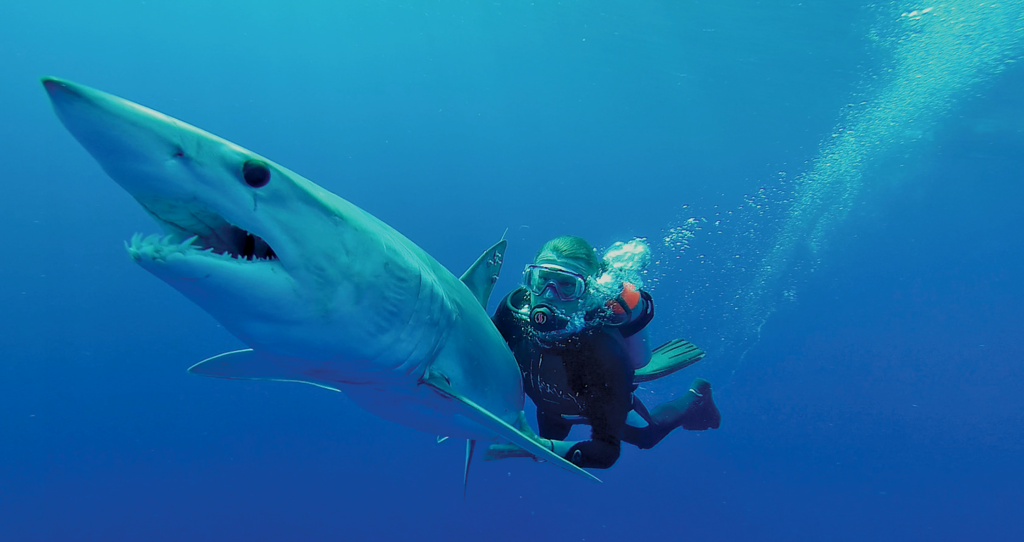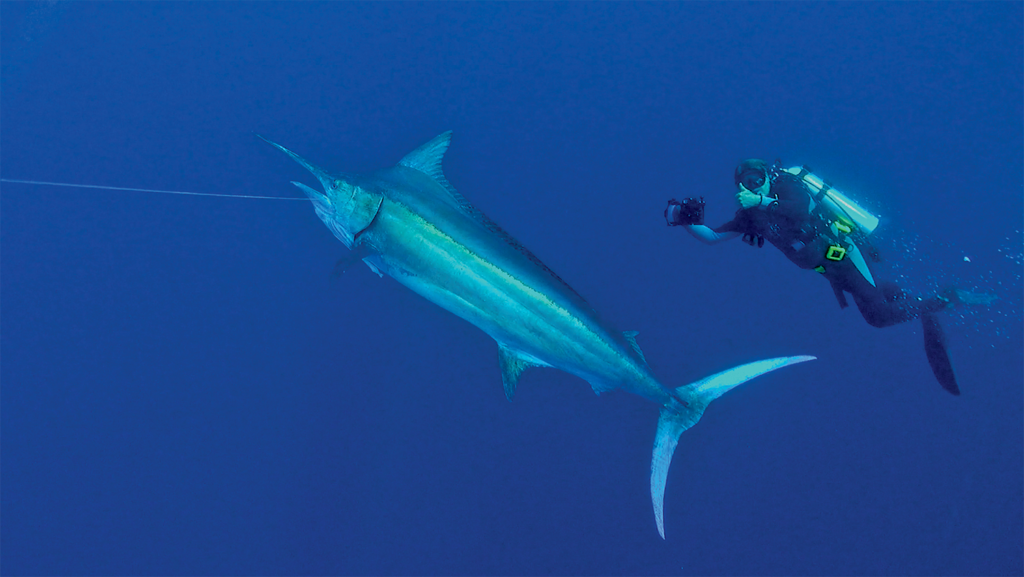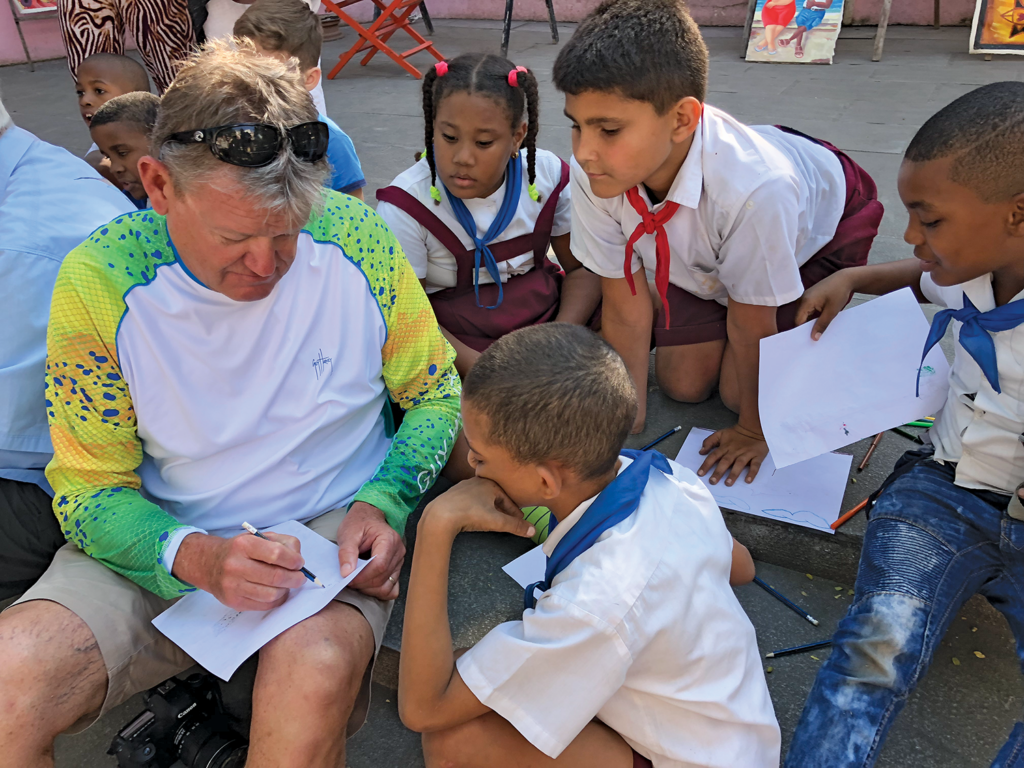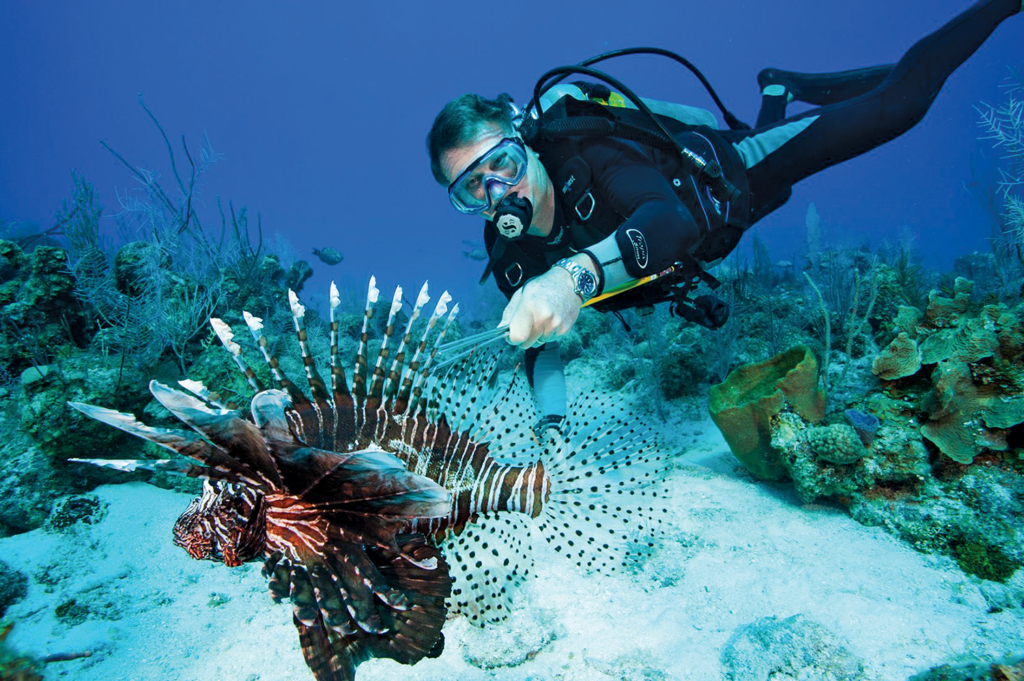Profiles in Leadership: Guy Harvey
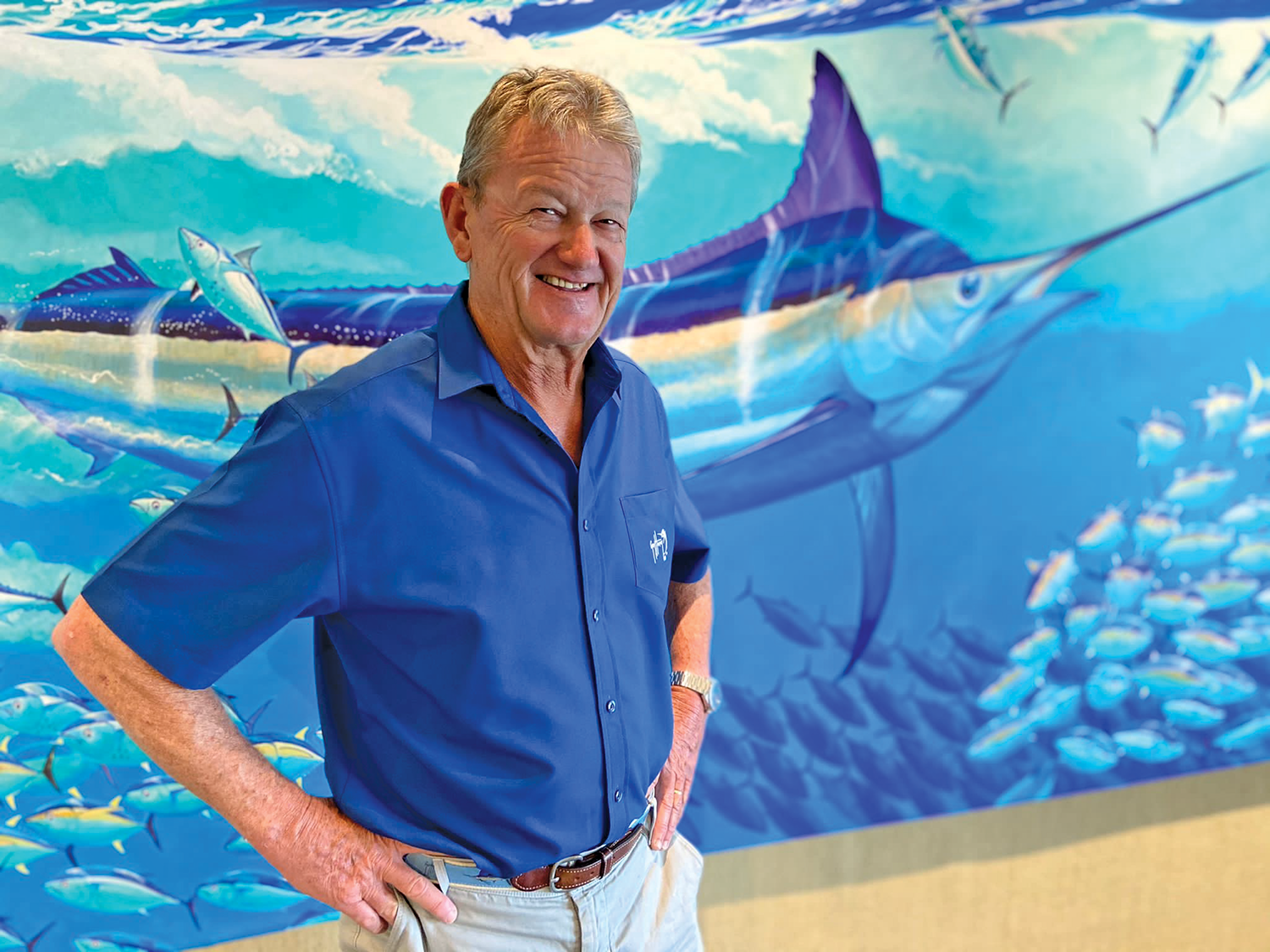
By Wanda Kenton Smith
In considering candidates for the Boating Industry Profiles in Leadership spotlight for the marine environment issue, the big catch was as crystal clear as the ocean he loves. While his name is synonymous with stunning marine art that graces everything from home goods to prints, posters, calendars, books and limited-edition canvas giclee from original art – to the spectacular 1200-foot hull of the Norwegian Escape – few on the blue planet are more passionate about ocean conservation and the marine environment than Dr. Guy Harvey.
Guy has received countless accolades ranging from lifetime achievement and hall of fame induction from the IGFA, to multiple awards for conservation, humanitarian, entrepreneurship, community service, science and sports achievements.
Boating Industry hooked up with Guy from his home in Grand Cayman to learn about the genesis that sparked a lifelong passion for the ocean as well as his mission to protect, preserve and promote the marine environment that is his beloved domain.
Boating Industry (BI): You grew up in Jamaica in an active family with parents who loved the water and the outdoors. Reportedly, your love for marine life was prompted by your mother’s gift of Ernest Hemingway’s classic, The Old Man and the Sea. What was it about the book that unleashed your creativity?
Dr. Guy Harvey (GH): I read the book when I was 12; at 17, I began a year-long project to illustrate the whole story properly. I considered the attempts made by other artists to be inadequate. Though completed in 1975, there were additional images done in 1989, to make 60 drawings. These were put in a book called Santiago’s Finest Hour in 1999 to celebrate Hemingway’s century year. Those original drawings are currently on display at the Key West Art and Historical Society’s Customs House in Key West, Fla.
BI: What was your early focus?
GH: I spent much of my early life as a student, as well as dabbling in art and selling a few original pieces here and there, including art featuring a lot of Caribbean birds. I also joined the Jamaica Defense Force Coast Guard (Navy) Reserve in 1978. Not only could I supplement my income as a PhD student, but I wanted to formalize my naval training, navigation and seamanship skills. I remained in the JDF for 10 years part time, reaching the rank of lieutenant.
BI: You earned degrees in marine biology with honors from Aberdeen University in Scotland, followed by a doctorate in fisheries science and management from the University of the West Indies in 1982. While subsequently teaching, I understand you ‘tested the waters’ to display some original limited-edition prints, which sold out and resulted in tremendous demand. Was that the official start of your business?
GH: My first one-man art show occurred in Jamaica in 1985 with subsequent shows in the Bahamas and in Florida in 1986. Guy Harvey Inc. and Guy Harvey Publishing were formed in 1987.
BI: Tell us about the size and scope of the organization today.
GH: Guy Harvey Inc. is a licensing company based in Ft. Lauderdale and has two flagship art galleries and stores; one on Las Olas, and the largest in the Grand Cayman. The Guy Harvey Foundation is based at the Guy Harvey Oceanographic Center at Nova Southeastern University. We have a total of 20 people in various locations. Both our children, Jessica and Alex are deeply involved; Jessica is CEO of the Guy Harvey Foundation and Alex is Director of Marketing and Licensing with the for-profit company, Guy Harvey Inc. The online presence – guyharvey.com – is licensed to Intradeco Inc., a Miami-based apparel manufacturer. There are also additional galleries situated at SeaWorld of Orlando and Busch Gardens in Tampa.
BI: What are your current responsibilities?
GH: My most important role is to create new art. I work in five different media including ink, watercolor, oil and acrylic paint as well as in photography. Mixed media is another popular style.
Over the last three decades, I’ve attended many consumer shows – boat shows, fishing and wildlife art shows – as well as marine industry trade shows and apparel shows in my role as founder and creator of the brand.
I’m a member of the prestigious Society of Animal Artists (SAA) and the Canadian-based Artists For Conservation (AFC). Both have an international membership of the best wildlife artists; each hosts annual travel exhibitions in North America.
I’ve authored four books: Portraits from the Deep; Panama Paradise; Underwater World; and 10,000 Chicken Sandwiches. I’ve also illustrated two books, Santiago’s Finest Hour (The Old Man and the Sea, Hemingway) and Fishes of the Open Ocean by Julian Pepperell.
BI: How many different art designs featuring marine species have you created?
GH: Perhaps 3000 works in my professional life, in different media, but my favorites are the big canvas paintings. The big pelagic fish and marine mammals I like to interact with and paint are large animals and deserve a big canvas.
BI: Any favorite personal fishing memories?
GH: Catching and releasing big fish, two blue marlin each over 1100 lbs. in one day, July 27, 1997, off Madeira, Portugal. Tagging and releasing a 1200 lbs. black marlin in Panama on January 25, 2005 with friends who caught the great fish. I keep a log of all the billfish catches by our family.
BI: What inspires you?
GH: While I enjoy painting very much, the other side of painting is sharing the experience, the knowledge gained through being self-taught, with other people, but particularly young people. During every appearance I make, whether at a Bass Pro Shop, SeaWorld, Busch Gardens, Dick’s, Macy’s, Academy Sports or Beall’s store, the kids want to share their art with me or even give me their art inspired by what I have painted. The art appeals to a wide, mainstream audience.
BI: What have been the biggest challenges you’ve faced in your career?
GH: Licensing art is tricky. The composition of the art is one thing, very time consuming but I love it. The ‘loneliness of a long-distance runner’ comes to mind. I do all my own artwork. I’m self-taught but have taken good advice from my closest friend in this genre, Kent Ullberg, America’s most famous artist and wildlife sculptor.
The tough side of the business is that you must defend your intellectual property. Copyright registration and hiring prickly lawyers to defend your IP is the best money you’ll ever spend in starting up your own visual arts business. By fiercely defending your IP, you set precedence; potential poachers soon learn not to plagiarize your art.
In terms of setbacks, there have been a few. The worst have always been about the ‘wrong’ person; hiring people who did not do what they said they could do; people in whom you placed your trust who turn out to be embezzlers and ‘puff daddies.’ I’m sure everyone starting out in a small business has had the same experience.
BI: When did you launch the Guy Harvey Foundation and what’s the mission?
GH: GHF was initiated in 2007 mainly to raise funds for the research projects conducted by GHRI and support other like-minded research and conservation organizations. Since 2020, the focus has been in the field of marine science education in schools in Florida and the Caribbean. We have put together curricula and other initiatives to better teach students, K-12, about the marine environment. We started in Florida and will be taking the experience to other states and the Caribbean.
BI: What’s your partnership with the Oceanographic Center at Nova Southeastern University (NSU)?
GH: This came first in 1999, before the formation of the GHF. After a dozen years of getting the business up and running, it was time to carve out a percentage of the proceeds from licensing and support research projects led by Professor Mahmood Shivji at NSU. These efforts were focused on shark and ray research but have expanded to billfish, tuna, dolphin fish, and other species, many of which are overexploited.
BI: Tell us about the stingray monitoring activity underway in the Grand Cayman.
GH: Long-lived animals like sharks and rays require long-term research projects to fully understand their life history and how we manage the use of the resource in a sustainable way. We began the stingray surveys in 2002. It is the longest running study of a marine interactive project, during which time we have tagged 650 individual rays, demonstrating how dynamic the population is in an open system.
BI: Why have you chosen to invest your time and resources in these causes?
GH: We need to learn so much more about the marine environment and the various ecosystems before we consume them all. Unregulated, unreported exploitation of marine resources is a massive problem. The implementation of Marine Protected Areas, based on more research, is one method of combating current rates of extraction. Time and area closures, based on science, also works. The other course of action is through more and better education to children worldwide about marine ecosystems, how they work, and how they can be harvested sustainably.
BI: What are your most notable successes on these fronts?
GH: 167 peer reviewed papers published by GHRI. No other brand in our genre has come anywhere near this level of achievement. Management of several critical species has been improved due to this research effort.
BI: What’s the key call-to-action for boating industry colleagues as it relates to marine conservation?
GH: Learn about the issues that humans impose on the ocean. Share your knowledge with family and friends; and take action. Support a research or conservation organization with funds, however small.
BI: Any mantras or keys to success?
GH: Never give up. Lead from the front. Be willing to learn. Be humble and treat people just as you would like to be treated.
BI: How do you stay on top of your game?
GH: The ocean is my teacher. I am constantly learning new facts every day about marine life. Each day, out on or in the water, is different; expect the unexpected. I take these experiences and turn them into art, a story that tells us something about the life history of the animal or fish I am painting. My art has become not only a collectable item of great value but also a tool for teaching the next generation.
BI: Finally, what’s ahead for Dr. Guy Harvey?
GH: Don’t stop the carnival!

